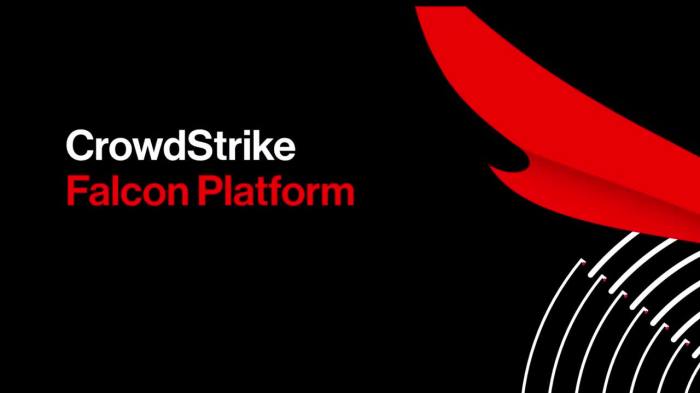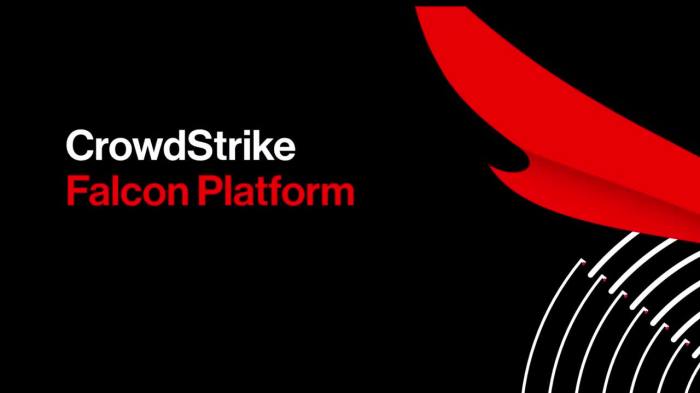Augment or replace SIEM with CrowdStrike Falcon? This deep dive explores the compelling potential of CrowdStrike Falcon to enhance or even completely replace your existing Security Information and Event Management (SIEM) system. We’ll examine the core functionalities of both Falcon and SIEM, evaluate your current infrastructure, and map out a strategic transition plan to maximize security and efficiency. The discussion will cover everything from data analysis and correlation to cost-benefit analysis and incident response.
A Security Information and Event Management (SIEM) system is a crucial component of any comprehensive security strategy. It collects and analyzes security logs from various sources to detect threats and anomalies. CrowdStrike Falcon, on the other hand, offers a more comprehensive security platform that goes beyond traditional SIEM capabilities. This article will explore the advantages and disadvantages of migrating to or augmenting your existing SIEM with CrowdStrike Falcon, considering both the technical aspects and the overall impact on your security operations.
Introduction to SIEM and CrowdStrike Falcon

Security Information and Event Management (SIEM) systems are critical components of modern cybersecurity architectures. They act as centralized hubs for collecting, analyzing, and correlating security events from various sources across an organization’s IT infrastructure. This allows security teams to identify patterns, anomalies, and potential threats in real-time, enabling proactive threat detection and response. SIEMs are designed to improve visibility into security posture, enhance incident response capabilities, and ultimately, reduce the risk of successful cyberattacks.CrowdStrike Falcon, on the other hand, is a comprehensive security platform that goes beyond traditional SIEM functionalities.
It integrates advanced threat intelligence, automated threat hunting, and proactive protection to deliver a more holistic approach to cybersecurity. Instead of simply logging and analyzing events, Falcon actively seeks out and neutralizes threats before they can cause significant damage. This proactive approach differentiates Falcon from traditional SIEM solutions, offering a more advanced, and often more effective, approach to security.
Thinking about augmenting or replacing your SIEM with CrowdStrike Falcon? It’s a big decision, and the current buzz around machine learning advancements is fascinating. For instance, Twitter’s recent acquisition of machine learning expertise, like in their “twitter machine learning magic pony acquisition” project, twitter machine learning magic pony acquisition , hints at the potential for even more sophisticated security solutions.
Ultimately, the choice to upgrade your SIEM to Falcon still hinges on your specific needs and budget, however.
Core Functionalities of SIEM
SIEM systems collect and analyze security logs from various sources, such as firewalls, intrusion detection systems, and endpoint devices. This comprehensive data aggregation allows for the identification of potential security threats and anomalies. Key functionalities include log aggregation, correlation, threat detection, and incident response. Correlating seemingly disparate events can reveal a coordinated attack or a more nuanced understanding of a persistent threat actor.
Effective SIEM solutions often provide dashboards and reporting capabilities to help security analysts monitor security posture and prioritize critical incidents.
Core Functionalities of CrowdStrike Falcon
CrowdStrike Falcon offers a more proactive and integrated approach to cybersecurity. Key functionalities include endpoint detection and response (EDR), threat intelligence, threat hunting, and security orchestration, automation, and response (SOAR). Falcon’s EDR component provides real-time visibility into endpoint activity, enabling rapid detection and response to threats. Threat intelligence feeds constantly update Falcon’s threat models, enhancing its ability to identify and respond to emerging threats.
Falcon’s automated threat hunting capabilities identify and prioritize potential threats that might be missed by traditional SIEM solutions. Falcon’s SOAR capabilities automate incident response workflows, reducing manual effort and response time.
Common Use Cases for SIEM and Falcon
Both SIEM and Falcon are designed to enhance an organization’s security posture. SIEMs are commonly used for log management, threat detection, and incident response. They are useful for monitoring network activity, identifying suspicious user behavior, and investigating security breaches. CrowdStrike Falcon is commonly used for endpoint protection, threat hunting, and incident response. It excels in identifying and neutralizing advanced threats, particularly those targeting endpoints.
Falcon’s focus on endpoint protection and threat hunting complements a SIEM, providing a more comprehensive view of an organization’s security posture.
Potential Benefits of Replacing or Augmenting a SIEM with Falcon
Replacing or augmenting a SIEM with Falcon can offer significant benefits, such as improved threat detection, faster response times, and reduced security risk. Falcon’s proactive threat hunting capabilities can identify advanced threats that might be missed by a traditional SIEM. Falcon’s integrated approach to endpoint security and threat response provides a more comprehensive view of the attack surface.
Automating incident response workflows can reduce manual effort and speed up the time to remediation.
Comparison of SIEM and CrowdStrike Falcon
| Feature | SIEM | CrowdStrike Falcon |
|---|---|---|
| Log Aggregation | Collects security logs from various sources. | Collects endpoint data, network logs, and threat intelligence. |
| Threat Detection | Identifies anomalies and patterns in security logs. | Proactively hunts for threats and uses machine learning for advanced threat detection. |
| Incident Response | Provides tools for incident investigation and response. | Integrates automated incident response workflows and threat hunting capabilities. |
| Endpoint Protection | Limited endpoint protection; often integrated with third-party tools. | Integrated endpoint detection and response (EDR) capabilities. |
| Threat Intelligence | Often relies on external feeds for threat intelligence. | Integrates with a comprehensive threat intelligence platform. |
Evaluating Current SIEM Infrastructure
A crucial step in considering a CrowdStrike Falcon deployment, either as an augmentation or replacement for your existing SIEM, is a thorough assessment of your current system. Understanding its strengths and weaknesses allows for a more informed decision. This evaluation helps to identify areas where Falcon can improve security posture and streamline operations.Thorough analysis of your existing SIEM’s capabilities, limitations, and data integration mechanisms is essential to ensure a smooth transition or effective augmentation.
This involves not just technical examination, but also consideration of how your team currently uses and interprets the data provided by the system.
Potential Weaknesses and Limitations
Identifying potential weaknesses in your existing SIEM system is paramount. These weaknesses might include insufficient log ingestion capabilities, leading to critical events being missed. Poor correlation and analysis of events can result in delayed detection of threats. Limited integration with other security tools can hinder a holistic view of your security posture. A lack of scalability to handle increasing data volumes can impact performance and response times.
Structured Framework for Assessment
A structured framework is necessary for a comprehensive evaluation. This should include:
- Log Source Integration: Assess the completeness and quality of log sources currently integrated into the SIEM. Identify any gaps or inconsistencies. Evaluate the efficiency of log ingestion processes. Are there any known bottlenecks? Are critical log sources missing?
Proper log ingestion is fundamental to threat detection and incident response.
- Data Correlation and Analysis: Analyze the effectiveness of the SIEM’s correlation rules and algorithms. Examine the timeliness and accuracy of threat detection. Do alerts adequately distinguish between legitimate events and security incidents? Review dashboards and reports for anomalies and potential false positives. This analysis will highlight areas where improvements are needed.
- Integration with Other Security Tools: Evaluate the level of integration with other security tools, such as firewalls, intrusion detection systems, and endpoint protection platforms. Assess how well these integrations work to create a unified security view. A lack of integration can lead to a fragmented security picture.
- Scalability and Performance: Assess the SIEM’s ability to handle increasing data volumes. Review system performance metrics to identify potential bottlenecks or limitations. How will the system handle anticipated growth in data? Consider the potential impact on processing time and incident response if the system cannot handle future demands.
Analyzing SIEM Dashboards and Reports
A critical component of the assessment involves analyzing existing dashboards and reports. Review the presentation and ease of use. Are the key metrics easily identifiable? Look for trends, anomalies, and potential indicators of compromise (IOCs) that may not be immediately obvious. Is the current visualization effective in conveying essential information?
Critical Metrics for Evaluation
Evaluating the SIEM’s effectiveness requires a set of critical metrics. This table provides a framework for comparison:
| Metric | Description | Target Value |
|---|---|---|
| Log Ingestion Rate (events/sec) | The rate at which the SIEM processes logs. | Should be sufficient to handle current and projected data volumes. |
| Alert Response Time (seconds) | Time taken to process and respond to security alerts. | Should be minimized for rapid incident response. |
| False Positive Rate (%) | Percentage of alerts that are not actual security incidents. | Should be minimized to reduce analyst workload. |
| Data Correlation Accuracy (%) | Accuracy of identifying related events in the security logs. | High accuracy is essential for effective threat detection. |
| System Uptime (%) | Percentage of time the SIEM is operational. | High uptime is crucial for continuous monitoring. |
Understanding CrowdStrike Falcon’s Capabilities
CrowdStrike Falcon is a comprehensive security platform that goes beyond traditional SIEM solutions. Its strength lies in its proactive approach to threat detection and response, built upon a cloud-based architecture and powerful threat intelligence feeds. This approach allows organizations to gain a deeper understanding of their threat landscape and react more effectively to evolving cyberattacks.Falcon’s capabilities extend far beyond basic log analysis, providing a holistic view of the entire security posture.
It leverages advanced machine learning and behavioral analytics to identify sophisticated threats that might be missed by a traditional SIEM. This proactive approach empowers organizations to stay ahead of emerging threats and respond swiftly to incidents.
Threat Detection and Response Strengths
Falcon’s threat detection capabilities are robust, leveraging multiple layers of security to identify and respond to threats. These include advanced threat intelligence, automated threat hunting, and real-time threat analysis. Falcon employs machine learning models trained on vast datasets to identify anomalies and malicious activity that traditional signature-based systems might miss. This advanced analysis allows for faster identification and mitigation of threats.
Integration with Existing Security Tools
Falcon integrates seamlessly with existing security tools, providing a unified security platform. This integration allows for a more comprehensive view of the security posture, enabling analysts to correlate data from various sources. This includes integrations with existing SIEM solutions, endpoint detection and response (EDR) tools, and other security information and event management (SIEM) systems. This interoperability enables a centralized platform for security analysis and incident response.
Augmenting or Replacing SIEM Functionality
Falcon can effectively augment or even replace traditional SIEM functionality. While a SIEM focuses on collecting and analyzing security logs, Falcon goes further by incorporating threat intelligence, automated threat hunting, and proactive threat response. This proactive approach enables security teams to detect and respond to threats faster than a SIEM alone. Falcon’s ability to analyze and correlate data from multiple sources, including endpoints, cloud environments, and network devices, provides a more complete picture of the threat landscape.
Thinking about augmenting or even replacing your SIEM with CrowdStrike Falcon? It’s a big decision, and the right tools can make a huge difference. While you’re considering this, it’s interesting to note how Google is expanding its Chromebook ecosystem with accessories like badges, chargers, keyboards, and mice, as detailed in this article: google works with chromebook badge accessories chargers keyboards mice.
Ultimately, the best approach for your security needs will depend on your specific setup and requirements, but CrowdStrike Falcon might be a strong contender for improving your overall security posture.
This holistic approach helps to augment the SIEM’s reactive capabilities, allowing for more proactive threat hunting and incident response.
Cloud-Based Architecture and Analysis
Falcon’s cloud-based architecture enables real-time analysis and threat detection. This architecture allows for rapid scalability and efficient processing of vast amounts of data. The cloud environment facilitates the storage, processing, and analysis of security data from diverse sources. The cloud-based infrastructure allows for a rapid response to security incidents and threats, providing the necessary agility to respond to a wide range of security incidents.
Threat Intelligence Feeds
Falcon leverages comprehensive threat intelligence feeds to enhance threat detection and response. These feeds provide up-to-date information on emerging threats, vulnerabilities, and attack techniques. These intelligence feeds are constantly updated, providing the latest insights into the evolving threat landscape. This enables security teams to adapt to new threats quickly, ensuring they are well-informed about the most current threats.
This comprehensive approach to threat intelligence equips security teams with the knowledge necessary to respond to sophisticated attacks effectively.
Planning the Transition Strategy
Successfully transitioning from a legacy SIEM to CrowdStrike Falcon requires a well-defined phased approach. This strategy ensures minimal disruption to existing operations while maximizing the benefits of Falcon’s advanced capabilities. Careful planning and execution are crucial to avoid data loss and ensure a smooth integration process.A phased approach allows for incremental adoption of Falcon’s features, enabling teams to test and refine procedures at each stage.
This iterative process mitigates risks and maximizes the potential of the new security platform.
Phased Approach to Integration
A phased migration strategy allows for a controlled introduction of Falcon into the existing security infrastructure. This approach minimizes disruption and maximizes the opportunity to learn and refine processes throughout the migration. Each phase should focus on a specific set of Falcon functionalities and data sources. A pilot phase, for example, can be used to test data mapping and transformation procedures, ensuring minimal risk before scaling the migration across the entire organization.
Data Migration Steps
The migration of data from the current SIEM to Falcon necessitates a structured approach. First, identify the data points that need to be migrated. Prioritize critical data, such as security events and alerts. Next, establish a data mapping strategy to align the current SIEM data model with Falcon’s structure. Thorough testing is critical at each stage to verify data integrity and consistency.
Develop scripts or tools to automate the data migration process to reduce manual effort and potential errors.
Data Mapping and Transformation Best Practices
Data mapping and transformation are critical components of the migration process. A clear understanding of the data fields and their corresponding relationships in both the current SIEM and Falcon is essential. Develop detailed mapping documents that explicitly define the rules and transformations required. Consider using ETL (Extract, Transform, Load) tools to automate the data migration and transformation process.
Establish robust validation procedures to ensure data integrity during the transformation process.
Thinking about augmenting or even replacing your SIEM with CrowdStrike Falcon? It’s a pretty hot topic right now, and the advancements in AI are making it a very compelling option. The recent innovations in AI are also being applied in other fascinating fields like healthcare, for example, how AI is powering COVID vaccine development in California. ai healthcare power covid vaccines california shows how this technology is changing the world.
Ultimately, the question of whether to augment or replace your SIEM with Falcon still comes down to a careful assessment of your specific security needs.
Potential Challenges and Risks
Potential challenges during the transition include data inconsistencies, compatibility issues between the current SIEM and Falcon, and the learning curve for personnel. Thorough testing and validation procedures are crucial to mitigate these challenges. Document all potential risks and create mitigation strategies to address them. Plan for downtime and implement failover procedures.
Necessary Resources and Personnel
The transition will require dedicated resources and personnel. Identify individuals with expertise in both the current SIEM and Falcon. Consider hiring external consultants or security experts to provide specialized support if necessary. Establish clear communication channels to facilitate collaboration and knowledge sharing. Allocate sufficient budget for training, tools, and potential consulting services.
Potential Migration Phases
| Phase | Activities | Timeline |
|---|---|---|
| Phase 1: Assessment and Planning | Define scope, identify data sources, create data mapping strategy, develop migration plan, allocate resources. | 2-4 weeks |
| Phase 2: Pilot Implementation | Migrate a small subset of data, test data mapping and transformation rules, validate data integrity, refine processes. | 4-6 weeks |
| Phase 3: Full Migration | Migrate all remaining data, integrate Falcon with existing security tools, conduct thorough validation, resolve issues. | 6-8 weeks |
| Phase 4: Optimization and Monitoring | Fine-tune Falcon configurations, optimize performance, monitor system health, and maintain the system. | Ongoing |
Data Analysis and Correlation Capabilities
CrowdStrike Falcon offers a significant departure from traditional SIEMs in its approach to data analysis and correlation. Instead of relying solely on predefined rules and signatures, Falcon leverages advanced machine learning and behavioral analytics to identify subtle anomalies and threats that might otherwise go unnoticed. This proactive approach allows for faster detection and response compared to traditional SIEM methods.
Falcon’s Data Analysis Capabilities vs. Traditional SIEMs, Augment or replace siem with crowdstrike falcon
Traditional SIEMs primarily rely on log aggregation and rule-based analysis. They excel at identifying known threats but often struggle with detecting novel or evolving attacks. Falcon, on the other hand, uses a combination of machine learning models and behavioral analysis to identify deviations from expected patterns. This allows for the detection of threats that traditional SIEMs might miss.
For instance, if a user typically logs in from a specific location at a specific time, an unusual login from a different location at an unexpected time might be flagged as suspicious by Falcon’s behavioral analytics.
Correlation of Events Across Multiple Data Sources
Falcon’s ability to correlate events across various data sources is a key differentiator. It doesn’t just analyze logs from a single endpoint; it aggregates data from endpoints, cloud services, network traffic, and more. This holistic view enables a more complete understanding of the attack lifecycle, allowing security teams to identify the initial compromise point and the subsequent actions taken by the attacker.
This comprehensive view is a substantial improvement over traditional SIEMs, which often struggle to connect disparate data points. A successful phishing attack, for example, might involve email activity, suspicious file downloads, and unusual network traffic. Falcon can correlate these events to build a more complete picture of the attack.
Threat Detection Capabilities Comparison
Falcon’s threat detection capabilities are significantly enhanced by its machine learning algorithms. These algorithms are constantly learning and adapting to new threats, ensuring a proactive defense against evolving attack techniques. Traditional SIEMs, while capable of detecting known threats, often rely on static signatures that might not be effective against new or modified malware. This reactive approach can leave organizations vulnerable to emerging threats.
A key difference lies in the speed and accuracy of detection. Falcon can identify malicious activity much faster than traditional SIEMs, significantly reducing the window of opportunity for attackers.
Threat Intelligence and Hunting Capabilities
Falcon provides a wealth of threat intelligence, including detailed information on known malicious actors, malware families, and attack techniques. This intelligence is constantly updated and integrated into the platform, empowering security teams to proactively identify and respond to emerging threats. Traditional SIEMs often rely on external threat intelligence feeds, which can be fragmented and less integrated into the overall security workflow.
Falcon’s integrated threat intelligence is readily available within the platform, enabling a more efficient and effective threat hunting process. Falcon also offers enhanced threat hunting capabilities, empowering security analysts to proactively identify and investigate potential threats. This is a key differentiator from traditional SIEMs which often focus on reactive incident response rather than proactive hunting. Falcon provides tools and information to aid in identifying patterns and behaviors that could indicate malicious activity.
Security Operations and Response
CrowdStrike Falcon significantly elevates security operations and response by providing a comprehensive platform for threat detection, investigation, and remediation. This shift moves beyond reactive measures to proactive threat hunting and incident response, allowing security teams to anticipate and mitigate risks before they impact the organization. Falcon’s automation and integration capabilities further streamline workflows, freeing up valuable time for more strategic tasks.
Falcon’s Enhanced Security Operations
Falcon’s advanced threat intelligence and machine learning algorithms allow for rapid detection of sophisticated threats, even those that evade traditional security systems. This proactive approach empowers security teams to respond to incidents with speed and precision, minimizing potential damage. Real-time threat intelligence updates keep the system current with emerging threats, which is crucial for modern cybersecurity.
Streamlined Incident Response with Automation
Falcon’s automation features significantly streamline incident response. Automated workflows and playbooks allow security teams to quickly and consistently address incidents, reducing the time-to-resolution. This automation can include tasks like isolating compromised systems, initiating remediation procedures, and notifying affected parties. These automated responses can dramatically reduce the response time and allow security teams to allocate their resources to more complex issues.
Integration with Other Security Tools
Falcon’s integration with other security tools enhances workflows and provides a unified security operations center (SOC) experience. This seamless integration allows for the correlation of data from various sources, providing a holistic view of the threat landscape. Security teams can easily leverage data from existing SIEMs, endpoint detection and response (EDR) tools, and other security applications to get a complete picture of the threat.
For instance, integrating with a vulnerability management system can allow Falcon to prioritize remediation efforts based on discovered vulnerabilities.
Reporting and Visualization Capabilities
Falcon offers comprehensive reporting and visualization capabilities to enhance security operations. Customizable dashboards, reports, and visualizations present key metrics and insights in an easily digestible format. This facilitates trend analysis, identifying patterns, and prioritizing remediation efforts. Security teams can effectively track and analyze threat activity, enabling more informed decision-making. For example, a graphical representation of endpoint infections over time can highlight potential vulnerabilities and inform targeted security measures.
Benefits of Falcon for Threat Hunting and Incident Response
| Feature | Benefit |
|---|---|
| Proactive Threat Detection | Early identification of sophisticated threats before they impact the organization, minimizing potential damage. |
| Automated Incident Response | Streamlined workflows and consistent incident handling, significantly reducing response time and improving efficiency. |
| Seamless Integration | Unified view of the threat landscape by correlating data from multiple security tools, improving threat detection and response. |
| Comprehensive Reporting | Data-driven insights and actionable intelligence through customizable dashboards, reports, and visualizations. |
| Advanced Threat Hunting | Enhanced ability to identify and investigate complex threats, using Falcon’s machine learning and threat intelligence capabilities. |
Cost-Benefit Analysis

Transitioning from a traditional SIEM to CrowdStrike Falcon requires careful consideration of potential costs and benefits. A comprehensive cost-benefit analysis is crucial to justify the investment and ensure a positive return on investment (ROI). This analysis should consider not only the upfront costs but also the long-term operational savings and improved security posture.
Potential Costs Associated with Implementing Falcon
The implementation of CrowdStrike Falcon involves various costs. These include licensing fees, the cost of integrating Falcon with existing infrastructure, potential retraining costs for security personnel, and the cost of any necessary hardware upgrades. It’s important to consider all these aspects when creating a comprehensive budget.
Comparing Falcon’s Total Cost of Ownership (TCO) with the Existing SIEM
A critical aspect of the analysis is comparing the total cost of ownership (TCO) of Falcon with the current SIEM solution. This includes not only the initial purchase price but also ongoing maintenance, support, upgrades, and potential staff training. Falcon’s subscription-based model might have a different TCO profile than the perpetual license model of some SIEMs. A thorough comparison, considering all factors, is necessary to determine the true cost-effectiveness of the transition.
Methods for Calculating ROI
Calculating the ROI for Falcon involves quantifying the potential benefits and comparing them to the costs. One method involves estimating the potential reduction in security incidents, the time saved in incident response, and the cost savings from preventing data breaches. A detailed model should consider the potential reduction in false positives, improved threat detection, and faster response times.
A critical aspect of ROI calculation is determining a quantitative value for each benefit, for instance, the financial loss associated with a security incident.
Potential Cost Savings from Improved Efficiency and Reduced Incident Response Times
Implementing Falcon can lead to significant cost savings through improved efficiency and reduced incident response times. Falcon’s proactive threat detection capabilities and automated response mechanisms can significantly reduce the time spent on investigating and resolving security incidents. This can translate into cost savings by freeing up security personnel to focus on more strategic tasks. Consider using case studies of organizations that have successfully implemented similar solutions to support your cost savings estimates.
Estimated Cost of Implementation for Each Phase
The implementation process can be divided into phases, each with its associated costs. A detailed breakdown of estimated costs for each phase will provide a clearer picture of the total financial commitment.
| Phase | Estimated Cost |
|---|---|
| Assessment and Planning | $5,000 – $15,000 |
| Data Migration and Integration | $10,000 – $30,000 |
| Falcon Deployment and Configuration | $15,000 – $45,000 |
| Training and Support | $5,000 – $15,000 |
| Ongoing Maintenance and Monitoring | $10,000 – $30,000 annually |
Note: These figures are estimates and may vary based on the specific requirements and scope of the implementation. Detailed cost breakdowns should be provided in the full implementation plan. External factors such as the size of the organization and the complexity of its infrastructure should be considered.
Closure: Augment Or Replace Siem With Crowdstrike Falcon
In conclusion, augmenting or replacing your SIEM with CrowdStrike Falcon presents a significant opportunity to bolster your security posture. The detailed comparison of features, evaluation of your current SIEM infrastructure, and strategic transition plan will equip you with the knowledge to make an informed decision. While Falcon’s strengths in threat detection, response, and automation are undeniable, a thorough cost-benefit analysis and careful planning are essential for a successful transition.
Ultimately, the decision depends on your specific needs and security priorities.





